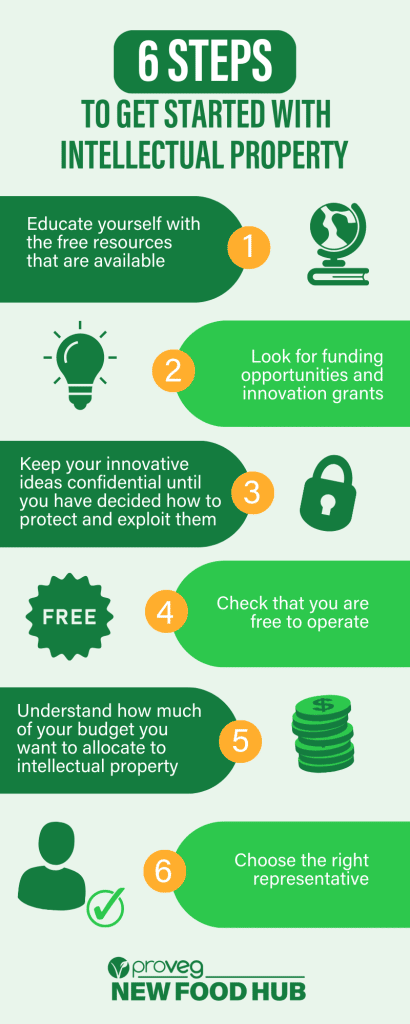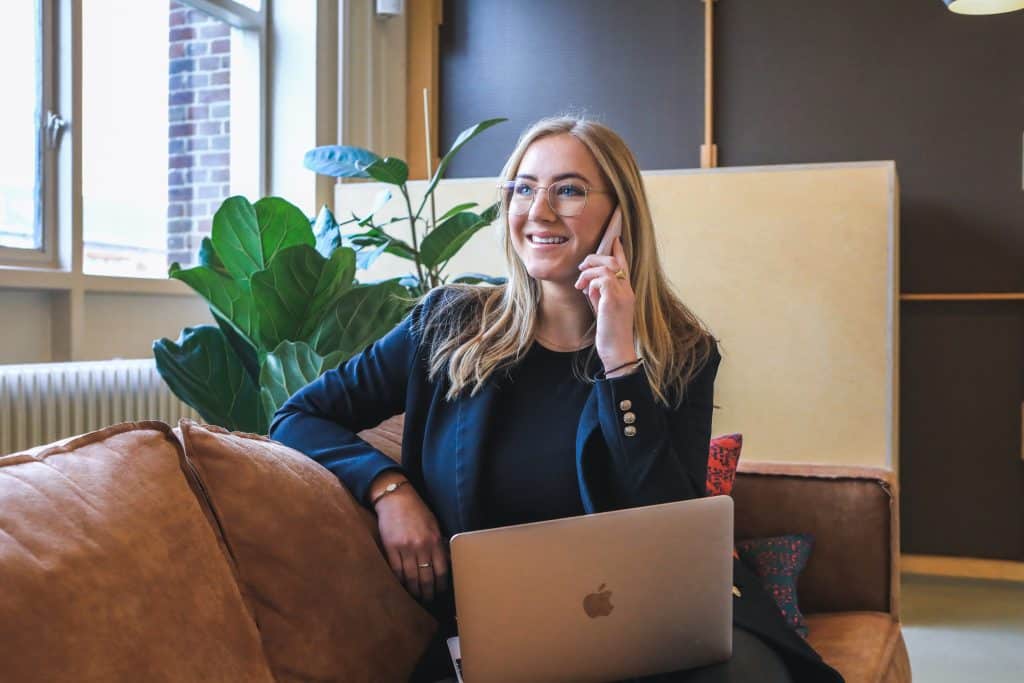This content was provided by Georgia Mann, an associate at Withers & Rogers law firm and does not necessarily represent the views or positions of ProVeg International. It is published here to add to the conversation on issues relevant to the plant-based sector and our readers.
Introduction from ProVeg
In recent years, innovation and investment in the plant-based and alternative-protein sectors have boomed. As the industry continues to grow, so will the need to protect market positions and intellectual property. However, for those just starting out, the world of patents and trademarks can seem intimidating and confusing. This New Food Opinions piece aims to provide an overview of intellectual property for startups and businesses in the food-and-beverage industry.
In partnership with law firm Withers & Rogers, ProVeg presents this how-to guide along, as well as an introductory webinar to intellectual property (IP) which you can register for here. Withers & Rogers is one of Europe’s largest dedicated IP law firms, with offices in the UK, Paris, and Munich. Read on to learn about:
- What intellectual property is and the different types of IP rights
- The benefits of protecting your IP
- The different processes for obtaining patents, trademarks, and registered designs
- Key actions you can take to get started with intellectual property
While Withers & Rogers’ expertise is in the UK and the EU, we have included additional tips provided by ProVeg for other regions.
Register for our free webinar
For more information on this topic make sure to register for our webinar in partnership with Withers & Rogers: An introduction to IP, happening 2 February 2023, 11:00 am CET.
What is intellectual property?
Intellectual property (IP) rights are intangible property rights that can be used to protect your creative ideas. They help to prevent others from copying, stealing, or profiting from your ideas without your consent.
What are the different types of intellectual property?
Intellectual property comes in many different forms, including patents, trademarks, designs, trade secrets, and copyright. Some intellectual property rights require a registration process, while others arise automatically.
It’s important to understand the main differences between various types of intellectual property in order to better understand which rights are most suitable for your business. A summary of rights relevant to the food-and-beverage industry is set out below.
What rights require registration?
1. Patents
A patent protects products (e.g. food, drink, packaging, and machinery), processes (e.g. production methods), and use of products. A granted patent provides up to 20 years of monopoly rights in order to make, sell, or use the invention.
To obtain a patent, an invention must be new (i.e. not disclosed anywhere in the world outside of conditions of confidentiality) and inventive (i.e. not an obvious modification of something already in the public domain).
2. Trademarks
A trademark protects your brand. Your trademarks may be the primary way that consumers recognise your products. Registration of a trademark prevents others from using the same or similar trademark.
A trademark can last indefinitely if it is renewed (typically every ten years) and continues to be used.
You can register words (e.g., Coca-Cola), moving images, logos, pictures, sounds, shapes and even colours (e.g., Heinz registered the turquoise colour used for its cans) as a trademark.
A trademark must be distinctive and should not be descriptive of the goods or services on which it is used. For instance, trademarks cannot describe the quality, purpose, or geographical origin of goods or services.
3. Registered designs
A registered design protects the way that something looks; for example, Coca-Cola obtained a design patent at the US Patent Office for their contoured bottle in 1915 (which has now expired).
UK-registered designs and EU-registered designs (known as ‘community designs’) can provide protection for up to 25 years. For many other countries, you can register your design under the World Intellectual Property Organisation’s (WIPO) Hague System. The initial protection period is five years and can be renewed to give at least 15 years of protection, unless a contracting party provides a longer duration of protection.1 China joined as a member of the Hague System in 2022, making it the 77th member of the Hague Union.2
To qualify for design registration, the design must be new and must create a different overall impression on the user from designs already in the public domain. A 12-month grace period is provided in most countries in which to validly file a design registration after the design has been first disclosed.

ProVeg Tips
Different regions have different systems. For instance, the Benelux Office of Intellectual Property covers registrations for Belgium, the Netherlands, and Luxembourg. While it is possible to get protection in most countries, it is best to verify the options available in your country, for example, by speaking to a local attorney.
What rights do not require registration?
1. Trade Secrets

Trade secrets include any piece of information which is purposefully kept confidential and provides economic value because it is kept secret. Reasonable measures need to be taken to keep the information secret.
Providing that the information remains secret, a trade secret can last indefinitely.
Examples include recipes, product information, marketing strategies, supplier lists, and business plans. Two of the most famous examples of trade secrets are the formulations of Coca-Cola and KFC’s seasoning blend.
If this type of intellectual property is valuable to your company, it is crucial to have a trade-secret management programme in place.
2. Copyright

Copyright prohibits copying, adaptation, or reproduction of original creative works. Copyright can be present in a wide array of original works, including instruction leaflets, blog posts, and other marketing.
Copyright exists automatically from the moment a work is created. The duration of the copyright depends on the type of work. For example, in the UK and the EU, protection for written work lasts until 70 years after the death of the author.
3. Unregistered design rights
An unregistered design right exists automatically upon the creation of a design. This prevents others from directly copying your design for up to 15 years in the UK (three years in the EU). An unregistered design right does not provide protection against someone independently arriving at the same design. Therefore, while it is beneficial, this right is less powerful than registered designs.
UK unregistered design rights only protect 3D shapes and configurations. EU unregistered design rights also protect 2D designs and surface decorations.
German and French laws do not provide protection for unregistered national designs. However, registered community designs are enforceable before German and French national courts.

ProVeg Tips
For countries or regions not discussed above, we recommend conducting your own research on whether protection is available for unregistered designs. For instance, unregistered designs in Japan may be able to be protected by the Unfair Competition Prevention Law under certain conditions.3
How can intellectual property help me?
Intellectual property is an increasingly important business tool for both companies and individuals.
Some of the advantages of protecting your IP include:
1. Revenue generation
Intellectual property can be licenced in exchange for a royalty payment or sold in the same way as physical assets.
2. Attract funding and investment
Intellectual property can play an important role in securing funding, such as grants for innovative research and development projects, or attracting investment from commercial partners.
3. Provide Tax Relief
In some countries, a granted patent can be used to reduce corporate tax on profits from the sale of a patented product or method.
4. Attract customers
Strong branding, attractive designs, and innovative patented technology can be powerful marketing tools.
5. Protect your market share
Intellectual property rights allow you to prevent similar products, branding, or designs from entering the market, thus allowing you to defend your position.
Register for our free webinar
For more information on this topic make sure to register for our webinar in partnership with Withers & Rogers: An introduction to IP, happening 2 February 2023, 11:00 am CET.
How do I get started?
Balancing the protection of your branding and/or innovative technology with the growth of your business can be a difficult juggling act, especially during the initial stages when financial resources are often limited. As such, protecting intellectual property is often overlooked or bumped down the list of priorities. However, the importance of protecting your IP assets should not be ignored.
Below are some tips for navigating intellectual property in order to ensure you make the most of your ingenuity.
1. Educate yourself

Intellectual-property assets can be of vital importance to both startups and established businesses. It is important to understand what intellectual property is, how it can be useful for your business, and how to protect it. The good news is that there are lots of free resources out there that can help.
Look out for IP clinics and sessions. For example, Withers & Rogers run IP clinics for local incubator and startup networks.
Browse the websites of IP firms. These often have useful knowledge banks of articles (e.g. there is a useful archive of articles from Withers & Rogers in our online knowledge bank, which you can find here).
Look out for and speak to friendly intellectual-property attorneys at trade shows and events. Some intellectual-property firms partner with industry bodies to provide free talks and webinars.
In Europe, the European Commission offers an IP Helpdesk, which provides a helpline, training, and IP resources. The European Intellectual Property Office also provides free intellectual property support through an online submission form. The World Intellectual Property Office (WIPO) also has resources available.
In the UK, the Chartered Institute of Patent Attorneys (CIPA) provides free advice and support to inventors, individuals, and small businesses across the country. The British Library also has a Business and IP centre, which offers a wide range of free or low-cost webinars, workshops, and events.
The German Patent and Trademark Office has some helpful information and resources that can be found here.
The French National Institute of Industrial Property (INPI) also provides help and support to guide you through your innovation strategy. Their resources are linked here.
Advice and information for other regions is widely available on the internet. Check with your local government and intellectual property law firms in your country for more useful resources.
If you are located in or connected to a university, it is likely that your institution will have a technology-transfer office that can advise you further.
Patent and trademark attorneys and firms often use social media to advertise free webinars and sector-specific conferences. Follow them on LinkedIn!
2. Look for funding opportunities and innovation grants
As mentioned above, intellectual property can help to secure funding or attract investment from commercial partners.
There are often funding opportunities available specifically for innovation and for protecting any intellectual property that arises from that innovation (e.g. through local government or a funding body).
For example, Horizon Europe is the EU’s main funding programme for research and innovation. The European Union Intellectual Property Office (EUIPO) also runs an SME fund to help small-and-medium-sized enterprises (SMEs) in the EU protect their intellectual property rights. EU funding is often organised through the national governments of member states.
In the UK, the British government has funding opportunities specifically for innovative research.
The German Patent and Trademark Office has a list of various funding opportunities for SMEs here.
BPI France offers support for innovation, for example, to help companies develop an intellectual property strategy or to provide support for experimentation. In addition, the French National Institute of Industrial Property (INPI) provides guidance on financing intellectual property here.
There may also be funding available for innovation in your specific sector. For example, Horizon Europe ran a funding programme specifically for ‘fair, healthy, and environmentally friendly food systems, from primary production to consumption’. Another example is an open call for food innovation to fund collaborative innovation projects, launched by the European Institute of Innovation and Technology (EIT), a body of the European Union.
Similar programmes are available in many other parts of the world. Check with industry associations and government departments in your country or region.
Keep a lookout for new opportunities for funding in your sector!

3. Keep your innovative ideas confidential until you have decided how to protect and exploit them
For some intellectual-property rights, it’s crucial to keep an idea secret before obtaining protection. Always err on the side of caution and keep that invention confidential until a decision has been made as to how you’d like to protect it. That way, you will not accidentally lose the option to protect the idea.
4. Check that you are free to operate
When your company is in its infancy, it can be difficult to allocate financial resources. However, it is worth committing to a freedom-to-operate analysis in order to best understand the market and what areas your competitors are operating in. A freedom-to-operate analysis ensures that your products, processes, or commercial activities do not infringe on anyone else’s intellectual property rights.
Provided that you have the resources, we would usually advise investing in this type of review prior to substantial investment into R&D projects in order to ensure that money is not wasted on projects that may ultimately become redundant because they cannot be commercialised without permission from a third-party IP rights owner.
However, freedom-to-operate opinions can be expensive. Therefore, make sure you discuss your budget and reasons for conducting this type of analysis with an attorney before instructing this type of work.
5. Have a clear business plan and understand how much of your budget you want to allocate to intellectual property
the commercial importance of intellectual property, which is why it is important to share your commercial goals and business plans with your attorney as early as possible in order to ensure that you receive the best advice.
Intellectual-property rights are generally obtained on a country-by-country basis (subject to some streamlining agreements). Inform your attorney where you need protection in order to help them create the best application-filing strategy for you.
6. Choose the right representative

Make sure you choose a professional representative – or firm – that is the right fit for you and has the appropriate expertise to help your business excel.
It’s important to select a firm that specialises in patents, trademarks, and/or designs. For example, in the UK, the Chartered Institute of Patent Attorneys (CIPA) and the Chartered Institute of Trade Mark Attorneys (CITMA) have a directory to enable you to find a patent or trademark attorney. In addition, you can search for European patent attorneys by name or country on the European Patent Office webpage.
If you are looking for a French patent attorney, you can find a directory here.
If you are looking for a German patent attorney, you can find a directory here.
It’s a good idea to make sure that the firm you choose has experience in your sector of interest. For instance, if you work in the food industry, check to see that the firm has a specialist food-and-drink department. As a result, the firm you select will not only understand the industry but will appreciate the problems that a company in your sector may face. As such, the commercial advice you receive will be more relevant.
It is also important that you choose an attorney or firm that you trust and foresee having a good working relationship with. There is often an assumption made that, as soon as you receive advice from a patent or trademark attorney, you will receive a bill. However, this is often not the case. Do not be afraid to pick up the phone and call an attorney. The likelihood is that they will provide initial advice free of charge. This also gives you the opportunity to get to know them and decide whether they are the right fit for you.
Engaging an attorney is a big decision. You will be working closely with them, most likely for a long period of time, so it’s vital that you’re confident that they are the right fit for your business.
What is the process for obtaining a patent?
The patent process usually starts with preparation of the application. It is usually worth investing in hiring a patent attorney to prepare your patent application on your behalf. Patent attorneys have extensive expertise in drafting these types of legal documents. They will handle the entire application process to ensure that nothing goes unnoticed.
Once the application is filed, a search is usually carried out by the patent office to identify any relevant publications and to determine whether your invention is new and inventive.
After 18 months, the application is published, after which the invention is disclosed to the public.
After publication, the patent application undergoes examination (i.e., a negotiation with the patent office to determine whether the idea is new and inventive). This is where the scope of protection of the monopoly right is ultimately determined. Once the patent is granted, you’ll need to pay maintenance fees (the timings of which depend on the jurisdiction where the patent is sought but is often yearly).
For more information, please find a timeline for a UK patent application, and a European patent application.

ProVeg Tips
It is worth checking local government websites for more information on specific countries. For example, South Africa has information on registering a patent here, while Chinese patents are administered by the China National Intellectual Property Administration).
What is the process for obtaining a trademark?
First and foremost, a registered trademark application can be filed at any time – even after the use of the trademark. Unlike patents, there is no requirement of confidentiality and the public use of the trademark before seeking registration can often be advantageous.
When registering your trademark, you will first need to decide what groups of goods or services you want to register your trademark for. For example, if you work in the food industry, you may require class 30 (i.e., pastry, honey, treacle, syrups, desserts, ices, non-medicated confectionery, prepared meals, snack foods, sauces, pies, and puddings).
Once filed, the Intellectual Property Office in question will examine the application, and search for similar trademarks. If any are identified, the proprietor of any earlier trademark will be notified; if they are concerned by your application, they will need to object during the opposition period.
The application is then published, and, if there are no objections to the registration of the trademark by third parties, it is usually registered shortly thereafter (e.g. around 4-6 months after filing a UK application).
Trademark registration must be renewed in order to keep it in force. In most jurisdictions, renewal fees are required every 10 years from the filing date.
For more information, please find a timeline for a UK trademark application.

ProVeg Tips
Information on trademarks for regions outside of the UK is easily available on the web. For instance, if you are in the US, you can find information about trademark applications here.
What is the process for obtaining a registered design?
Registered designs are rarely examined. Instead, they are often granted in a short space of time, with their validity only being called into question upon enforcement. Often, they will be registered in as little as five weeks.
Registered designs in the UK are administered by the Intellectual Property Office. Community Registered Designs, which cover the entire EU, are administered by the European Union Intellectual Property Office, although national offices also register designs on a country-by-country basis.
For more information, please find a timeline for an international design protection filing strategy.
Summary

IP protection can seem daunting at the beginning of your company’s journey, but there is a lot of information available to help you protect your innovative technology. Don’t be afraid to pick up the phone and call an attorney. Most firms will provide initial advice to help you get started.
Let’s recap some of the key actions you can take:
- Educate yourself: attend free webinars and IP clinics and access the free resources available on IP firms’ websites. (Register for our free webinar on this topic here.)
- Research funding opportunities: check for IP-protection funding programmes available via your local government or within your specific industry.
- Keep your ideas confidential until you know how you wish to protect them.
- Consider conducting a freedom-to-operate analysis and timely reviews in order to navigate existing rights.
- Determine in which countries or regions you will need protection for your product/idea.
- Share your commercial and business goals with an attorney that you trust to work out a financially viable way to obtain protection for your IP.
Creating an IP portfolio is not always considered in the earliest stages of building a business or startup, but investing in a well-thought-out IP strategy from the start will enhance your overall commercial value, maximise potential, and can set you apart from the competition.
If you’re an innovative startup in the alternative-protein industry, make sure to check out the ProVeg Incubator for events and opportunities.
Register for our free webinar
For more information on this topic make sure to register for our webinar in partnership with Withers & Rogers: An introduction to IP, happening 2 February 2023, 11:00 am CET.
References
- WIPO, How Does the Hague System Work? Available at: https://www.wipo.int/hague/en/how_hague_works.html. Accessed: 2022-12-29
- Rouse, China’s Design Patent Registration System Going Global. Available at: https://rouse.com/insights/news/2022/china-s-design-patent-registration-system-going-global. Accessed: 2022-12-29
- World Trademark Review, Protecting and enforcing design rights: Japan. Available at: https://www.worldtrademarkreview.com/global-guide/designs/2020/article/protecting-and-enforcing-design-rights-japan. Accessed: 2023-01-19



